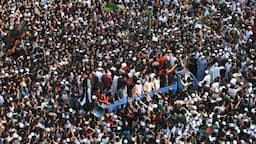India's weaknesses in the international framework.
U.S. tariffs were generally 2–3% for twenty years until April 2024, but the recent increase signifies a significant change.

In exchange for easing tariffs, the U.S. is seeking increased market access, particularly for agricultural and dairy goods, potentially harming Indian farmers.
Although India is a U.S. ally, it encounters higher tariffs than China (which have now been cut to 30%).
The tariff conflict emphasizes India’s weaknesses in the international framework.
the-tariff-assault
China's impact
China’s supremacy arises from its enormous manufacturing capability and technological expertise.
China accounts for 36.3% of worldwide textile exports and 24.9% in machinery/electricals; India follows with 4.4% and 0.9% respectively.
The original 145% tariffs on China were lowered following diplomatic discussions.
Repercussions for India
Comparative Disadvantage: Indian exports (such as textiles) now encounter increased tariffs compared to rivals like Vietnam and Bangladesh, rendering them uncompetitive.
Risk of Trade Deficit: Indian external balance depends on U.S. export revenues; tariffs jeopardize this revenue stream.
Sectoral Vulnerability: Job and income losses may impact textiles, pharmaceuticals, and IT services.
Investment Implications: Ongoing tariff uncertainty could discourage global companies from relocating supply chains to India.
India's Strategic Choices
Collaborate with the U.S. to adjust tariffs and safeguard key industries.
Utilize WTO and regional organizations to challenge unfair trade practices.
Transition from export-oriented to consumption-based growth through increasing wages and spending.
Increase public investment to enhance human capital and resilience.
Allocate resources to high-value industries (technology, pharmaceuticals, renewable energy) to decrease reliance on low-wage competition.
Youth's influence: Indian immigrants in the U.S. have succeeded in education, technology, and entrepreneurship and have played a role in U.S. technological and economic supremacy.
Limiting Indian professionals from U.S. employment or visa opportunities could negatively impact U.S. interests in the long run.
Guarantee fair access to chances to avert societal division.
Conclusion and Future Direction
India's best defence against international economic volatility is a strong domestic market, empowered youth, and innovation-led growth.

This necessitates quick increases in incomes and wages as well as investment in tech-driven, high-value industries.
Since India's 120 million young people (ages 15 to 29) have the potential to drive a knowledge economy, more vocational training, STEM education, and digital literacy are required.
Use diaspora networks to spread technology and gain international clout.










-1920x1080.jpg&w=256&q=75)





